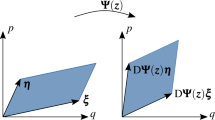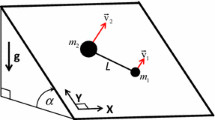Abstract
Constraint equations arise in the dynamics of mechanical systems whenever there is the need to restrict kinematically possible motions of the system. In practical applications, constraint equations can be used to simulate complex, connected systems. If the simulation must be carried out numerically, it is useful to look for a formulation that leads straightforwardly to a numerical approximation.
In this paper, we extend the methodology of our previous work to incorporate the dynamics of holonomically and nonholonomically constrained systems. The constraint equations are cast in a variatonal form, which may be included easily, in the time finite element framework. The development of the weak constraint equations and their associated “tangent” operators is presented. We also show that this approach to constraint equations may be employed to develop time finite elements using a quaternion parametrization of finite rotation. Familiarity with the notation and methodology of our previously presented work is assumed.
Similar content being viewed by others
References
Bailey, C. D. (1981): Application of Hamilton's law to forced, damped, stationary systems. J. Sound Vib. 75, 117–126
Simkins, T. E. (1981): Finite element for initial value problems in dynamics. AIAA J. 13, 1154–1157
Baruch, M.; Riff, R. (1982): Hamilton's principle, Hamilton's law, 6n correct formulations. AIAA J. 21, 687–692
Borri, M.; Mello, F. J.; Atluri, S. N. (1990): Variational approaches for dynamics and time-finite-elements: numerical studies. Comput. Mech. (in press)
Borri, M.; Ghiringhelli, G. L.; Lanz, M.; Mantegazza, P.; Merlini, T. (1985): Dynamic response of mechanical systems by a weak Hamilton's formulation. Comput. Struct. 20, 495–508
Lanczos, C. (1964): The variational principles of mechanics. University of Toronto Press
Neimark, Iu. I.; Fafaev, N. A. (1972): Dynamics of nonholonomic system. Providence, RI: American Mathematical Society
Borri, M.; Mantegazza, P. (1986): Finite time elements approximation of dynamics of nonholonomic systems. Presented at ASME Congress, Williamsburg, VA
Borri, M.; Atluri, S. N. (1988): Time finite element method for the constrained dynamics of a rigid body. Proc. ICES-88, Atlanta, GA
Iura, M.; Borri, M.; Atluri, S. N. (1988): Analysis of traveling wave responses of structures. Proc. ICES-88, Atlanta, GA
Author information
Authors and Affiliations
Additional information
Communicated by G. Yagawa, October 15, 1989
Rights and permissions
About this article
Cite this article
Borri, M., Mello, F. & Atluri, S.N. Primal and mixed forms of Hamiltons's principle for constrained rigid body systems: numerical studies. Computational Mechanics 7, 205–220 (1991). https://doi.org/10.1007/BF00369980
Issue Date:
DOI: https://doi.org/10.1007/BF00369980




